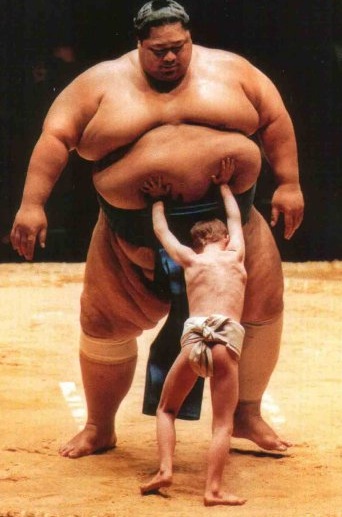
I've proudly borrowed this photo of aigamaeate from the
British Aikido Association as an example of what I'm talking about in this post.
.
Today's class included Chops and myself and we worked through most of the syllabus looking at some of the things that seem to differentiate my class from Usher-san's.
Usher is a kata man from a Shotokan background and is very good at the kata. I have often wished that my students and I had the precision that Usher has in his kata. But then, I see kata as a different kind of thing than Usher-san does.
I feel that the precision in kata should be secondary to
robustness. If your idea of the ideal of kata is something like, "step 45 degrees inside, push just so, turn 30 degrees, etc..." then your kata has the potential for precision but lacks the potential for being robust. That robust response is something that must be developed in randori. On the other hand, if you define kata as something like, "step out of the way, get your hands up, turn to face him, get behind his arm, follow him..." then your kata has potential to be robust in that it will work for a wider range of attacks, but sometimes it seems that this sort of kata lacks the potential for precision.
So, what role does precision play in a kata concept like mine? In what sense can you strive for precision and still maintain robust response? One of the reasons that you want to do kata the same way every time is because, even if that way turns out to be wrong, it is easier to fix a consistent mistake than a random error. If you do something different every time then you have a hard time isolating the variable to work on correcting.
As an example, let's take #2 - aigamaeate. I was tori and Chops was uke but because we're from different schools we went into the attack expecting uke to do different things. Chops, being an accomodating uke, was giving me a reaction that would have made a beautiful aigamaeate if I were doing the precise kata version Chops was accustomed to. I missed that reaction completely and didn't get the aigamae he was expecting, but because I was doing a robust form of aigamae, I cycled around him a step and then launched him away from me. Chops says it was the longest fall he's ever taken (though I didn't really see a satisfactory amount of air under him :-). That was sorta a round-about way of saying that my kata has precision too. I'm doing the same, robust form of aigamae every time, but the form of the thing takes into account more potential variability from uke.
You have to find a way to make your kata both robust and precise.
At the end of class, Chops asked for a "Cool Ninja Technique of the Day" from Owaza, so we ran through the last five techniques as a preview for him. Neat exercise, Owaza is.



 So, I've heard various people express their opinion that the introduction of weight classes in judo competition is greatly responsible for the perceived decline of judo from a technical height in the 1950's. In a
So, I've heard various people express their opinion that the introduction of weight classes in judo competition is greatly responsible for the perceived decline of judo from a technical height in the 1950's. In a 





